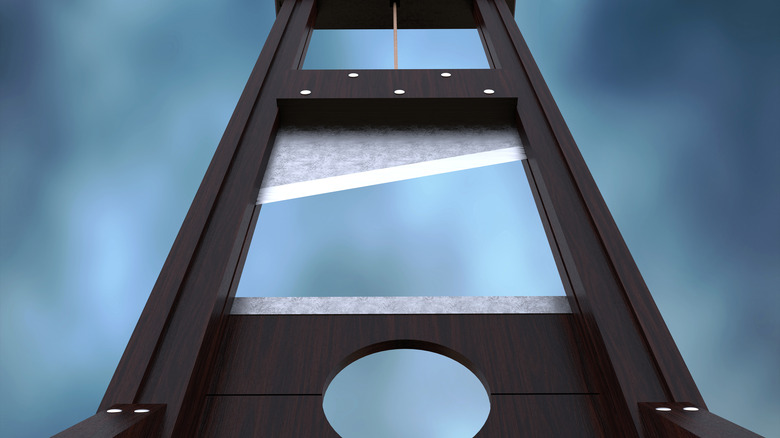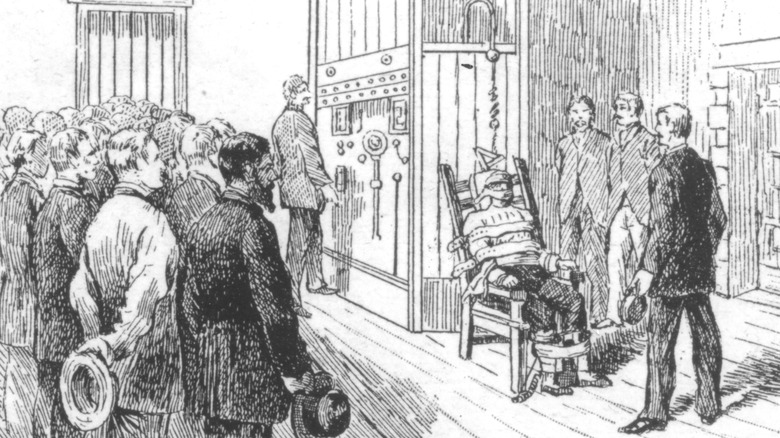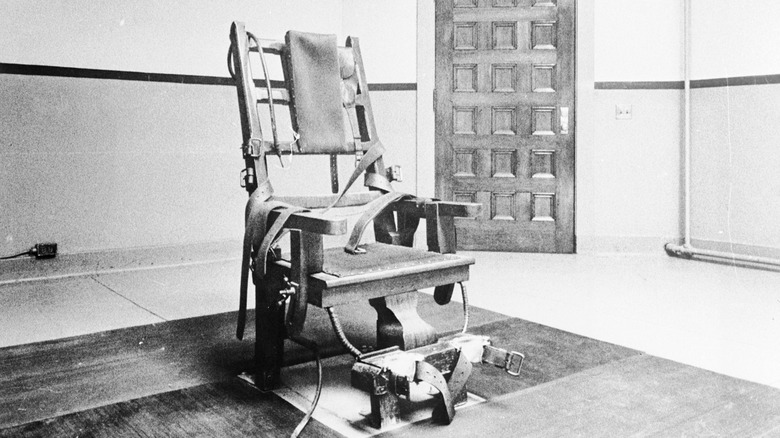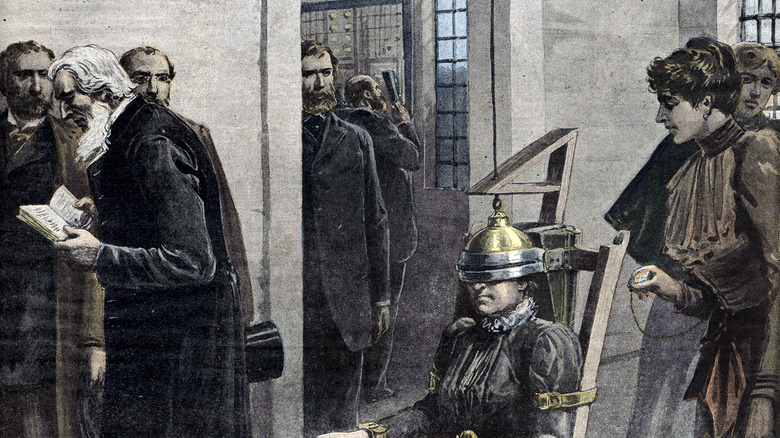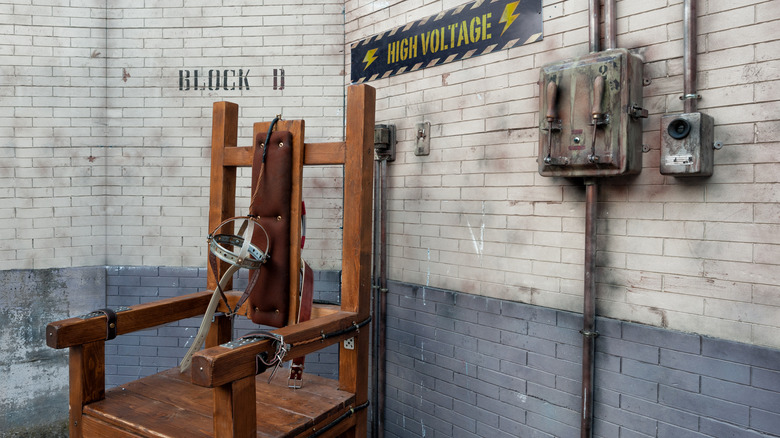What It's Like To Be Executed In An Electric Chair
Not that any execution method is pleasant, but meeting an end by way of the electric chair sounds particularly unpleasant. The thought of spending your last few moments on Earth strapped tightly to a chair and waiting patiently for the moment that thousands of volts of electricity course through your body sounds like there isn't a last meal in the world delicious enough to make that even remotely tolerable.
Some of history's most notorious criminals have met their maker while seated in an electric chair. Among them are serial killers Ted Bundy and Albert Fish, gangsters Harry Pierpont and Emanuel "Mendy" Weiss, and Giuseppe "Joe" Zangara, who attempted to assassinate Franklin D. Roosevelt in 1933, just to name a few (via Ranker).
It's a quick death — if it works on the first attempt, according to Ranker — with gruesome side effects that can include eyes popping out of the subject's head. What's perhaps most strange about it is that no one is exactly sure how the electric chair ultimately kills those who are forced to sit in it.
A history of capital punishment
According to the Death Penalty Information Center, capital punishment has been around for a long, long time. As far back as the 18th century B.C. criminals were paying for their unlawful doings with their lives. Back then, Babylon's King Hammurabi had marked death as the penalty for 25 different crimes. From there the death penalty became a popular addition to sets of laws through history, with civilizations ranging from the Hittites to the Romans to the Greeks and beyond.
That trend has remained relatively unchanged, but what has changed drastically over the years is the methodology through which executions were carried out. "Humane" isn't a word that springs to mind for many of history's more archaic methods like boiling, crucifixion, skinning alive, impaling, drawing and quartering, and immurement (which was basically trapping someone in a confined space for the rest of their life), and the exactly-what-it-sounds-like rat torture (via World Atlas).
Technological advancements led to the electric chair
Of course, before electricity could be used as a way of carrying out executions it had to be harnessed, but once that happened it didn't take too long before some said, "Hey, we could probably execute people with that." The first person to say that was a dentist named Dr. Albert Southwick, who in 1881 suggested electrocution could make for a humane method of execution. The moment that sparked the idea — pun very much intended — happened in Buffalo New York where Southwick watched a drunk man touch an electrical generator and was met with a swift, allegedly painless death (via History).
At the time of Southwick's suggestion, the most commonly used method of execution was hanging. Under the right circumstances, hanging could offer a quick, humane death, but that often wasn't the case, and subjects sometimes spent a grueling stretch of time — sometimes as long as 30 minutes — gasping for breath while still hanging by the neck.
New York was the first state to adopt a law permitting executions by electricity, and because it was such a new thing, Edwin R. Davis, the electrician at the prison in Auburn, New York was enlisted to design the first electric chair.
How an execution in the electric chair works
According to History, the original electric chair delivered its potent shock through two metal electrodes which were applied to the condemned's head and back. These were then covered by a damp sponge. Modern electric chairs followed pretty much the same concept. The person being executed is shaved in the areas where the electrodes will be attached, and then they are strapped to the chair using a series of belts (via Death Penalty Information Center). Once again a damp sponge is used, placed under the metal cap which is then positioned over the victim's head. The dampness of the sponge is important because if it's too wet it can cause an electrical short, but if it's too dry it may not be conducive enough to properly carry out the execution.
Once everything is hooked up and strapped, the prisoner is blindfolded and everyone present leaves the execution chamber and goes to the observation room. When given the signal, the executioner throws the switch, and 500 to 2,000 volts charge through the prisoner's body for 30 seconds. Once the body relaxes, a doctor checks to see if the prisoner's heart is still beating. If it isn't then it's over, but if there's still a heartbeat, the process repeats until the prisoner is dead.
What happens to a prisoner's body during an execution in the electric chair?
There are quite a few things that can happen to a person's body when they are subjected to such high amounts of electricity. According to Death Penalty Information Center, the prisoner's hands may grab the arms of the chair very tightly or their body could start twitching. The involuntary movements can be so violent that they cause internal damage like dislocations or even broken bones.
Supreme Court Justice William Brennan once offered the following colorful description of what happens to those condemned to death in the electric chair: "... the prisoner's eyeballs sometimes pop out and rest on [his] cheeks. The prisoner often defecates, urinates, and vomits blood and drool. The body turns bright red as its temperature rises, and the prisoner's flesh swells and his skin stretches to the point of breaking. Sometimes the prisoner catches fire. ... Witnesses hear a loud and sustained sound like bacon frying, and the sickly sweet smell of burning flesh permeates the chamber." Deputy chief medical examiner of Cook County, Illinois, Robert H. Kirschner, once noted that following an execution, a prisoner's brain "appears cooked in most cases."
Where have electric chairs been used?
The electric was introduced in the United States back in the 19th century and that's more or less where it has stayed since. It was the most commonly used execution method until lethal injection took over that distinction toward the end of the 1900s and into the 2000s (via Britannica). There was a sharp decline in the number of instances in which the electric chair was used after the 1972 moratorium on the death penalty put in place by the Supreme Court which lasted until 1976, per the National Constitution Center. However, between 1890 and 1972, electrocution was the method used in 4,251 executions. From 1976 to the present day, it has only been used 160 times.
States where the death penalty is still active sometimes offer prisoners the choice of being executed by either electrocution or lethal injection, while Nebraska was the last state to only use electrocution. Outside the United States, the electric chair is rare and isn't used even by countries that carry out the most executions — which according to the BBC included China, Iran, Saudi Arabia, Iraq, and Egypt as the top five in 2019, with the United States in sixth. However, the Philippines used the electric chair until 1976.

